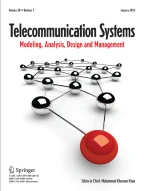Abstract
UMTS Terrestrial Radio Access Network (UTRAN) Transport Network Layer dimensioning has been of great interest among network researchers and planners due to the limit of Iub bandwidth. This paper investigates the potential impacts caused by Connection Admission Control (CAC) mechanism of the air interface and User Mobility (UM) on simulations carried out for the UTRAN transport network domain. Independent from the TNL CAC mechanism of the transport network which is in charge of Iub link bandwidth, the Radio CAC function deals with the highly non-linear resources needed for an attempted connection depending on its specific propagation and interference situation. The consideration of the air interface acting as bottleneck results into a less challenging amount of traffic for the transport domain. In addition, mobile user behaviors, e.g. UM, may dynamically change traffic load at the air interface, and in consequence affect Iub load, which has a very close correlation with cell load. In this work, a simulation model with Radio CAC mechanism and Handover strategies is implemented to study this correlation, and evaluate the UTRAN transport network performance given a limited radio capacity. The analysis on the impacts of the Radio CAC and UM are derived from qualitative simulations.
Similar content being viewed by others
Explore related subjects
Discover the latest articles, news and stories from top researchers in related subjects.References
Holma, H., & Toskala, A. (June 7, 2000). WCDMA for UMTS: radio access for third generation mobile communications. 1st ed. Wiley Technology Publishing.
3GPP TS 25.401 v3.10.0, 3rd Generation Partnership Project. (June 7, 2000). Technical specification group radio access network; UTRAN overall description (Release 1999). 1st ed. Wiley Technology Publishing.
Sipilä, K., Honkasalo, Z.-C., Laiho-Steffens, J., & Wacker, A. (2000). Estimation of capacity and required transmission power of WCDMA downlink based on a downlink pole equation. In VTC 2000 (pp. 1002–1005).
Dou, C., & Chang, Y.-H. (2005). Class-based downlink capacity estimation of a WCDMA network in a multiservice context. Computer Communications, 28, 1443–1455.
Li, X., Schelb, R., Timm-Giel, A., & Görg, C. (March 2006). Dimensioning of UTRAN iub links for elastic internet traffic with multiple radio bearers. In 13th GI/ITG conference measuring, modelling and evaluation of computer and communication systems, Núrnberg.
Weerawardane, T., Li, X., Timm-Giel, A., & Görg, C. (September 2006). Modeling and simulation of UMTS HSDPA in OPNET. In OPNETWORK 2006, Washington DC, USA.
Akl, R., Hegde, M., & Chandra, A. (April 1998). CCAP: CDMA capacity allocation and planning. Washington University, Missouri, USA.
Author information
Authors and Affiliations
Corresponding author
Rights and permissions
About this article
Cite this article
Chen, Y., Li, X., Timm-Giel, A. et al. Impacts of air interface admission control and user mobility on UTRAN transport simulations. Telecommun Syst 43, 121 (2010). https://doi.org/10.1007/s11235-009-9198-1
Published:
DOI: https://doi.org/10.1007/s11235-009-9198-1
